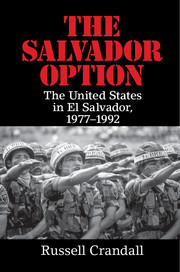Book contents
- Frontmatter
- Dedication
- Epigraph
- Contents
- List of Figures
- List of Organizations
- Acknowledgments
- 1 Introduction
- PART ONE EL SALVADOR IN THE COLD WAR
- PART TWO JIMMY CARTER
- PART THREE RONALD REAGAN
- PART FOUR GEORGE H. W. BUSH
- 39 Elusive Justice
- 40 Pessimism
- 41 Bush Arrives
- 42 Bush, Cristiani, and the 1989 Vote
- 43 Guerrilla Second Final Offensive, November 1989
- 44 Jesuit Killings
- 45 SAMs
- 46 United Nations and Peace
- 47 Demobilization
- PART FIVE POSTWAR
- Notes
- Bibliography
- Index
43 - Guerrilla Second Final Offensive, November 1989
from PART FOUR - GEORGE H. W. BUSH
Published online by Cambridge University Press: 05 June 2016
- Frontmatter
- Dedication
- Epigraph
- Contents
- List of Figures
- List of Organizations
- Acknowledgments
- 1 Introduction
- PART ONE EL SALVADOR IN THE COLD WAR
- PART TWO JIMMY CARTER
- PART THREE RONALD REAGAN
- PART FOUR GEORGE H. W. BUSH
- 39 Elusive Justice
- 40 Pessimism
- 41 Bush Arrives
- 42 Bush, Cristiani, and the 1989 Vote
- 43 Guerrilla Second Final Offensive, November 1989
- 44 Jesuit Killings
- 45 SAMs
- 46 United Nations and Peace
- 47 Demobilization
- PART FIVE POSTWAR
- Notes
- Bibliography
- Index
Summary
If the Cold War is over, why are we in El Salvador?
– Charles Krauthammer, Washington Post columnist, December 1989Given their mutual hostility and suspicions, one might have assumed that the FMLN and incoming rightist Cristiani administration would not have talked peace. Yet it appeared that both sides still saw the value of at least sitting down at the negotiating table with their sworn enemy. In fact, the two ideologically polar sides agreed on church-moderated talks – the first since discussions broke down in 1987. The negotiations concerned an FMLN proposal that called for a permanent cessation of hostilities within three months, predicated on “sweeping political reforms,” the demobilization of the rebel army, and the establishment of the FMLN as a legal party. The rebel proposal even called on the U.S. Congress to transform military aid to El Salvador into an assistance plan aimed at the “economic and social recovery of the country.” The first meeting took place in September 1989 in Mexico City, followed by a second meeting a month later in Costa Rica, where talks failed to produce a ceasefire but both sides agreed to continue the meeting in late November in Caracas, Venezuela. Any prospects of peace, however, were abruptly disrupted by renewed warfare.
In June 1989, U.S. Army officer Larry Cline arrived in El Salvador as part of an assignment with the 7th Special Forces Group to work with the FAES General Staff on communications issues. As Cline settled into his new position, he and some of his fellow American officers noticed that the FMLN had ratcheted up the snatching of teenage boys to add needed foot soldiers to the depleted guerrilla ranks, a practice that often began in the weeks and months before large rebel offensives. What Cline did not fully realize at the time, however, was that the FMLN was on the verge of launching a massive operation with far more fury than had been attempted in the vaunted final offensive in January 1981.
Reflecting months of planning in consultation with Havana and relying on key logistical support from the Sandinistas, the FMLN's second “final offensive” dubbed Al Tope y Punto (“all at once to the maximum”) began on the morning of November 11 when urban commandos launched mortar attacks against National Guard installations and FAES General Staff headquarters in the capital.
- Type
- Chapter
- Information
- The Salvador OptionThe United States in El Salvador, 1977–1992, pp. 431 - 441Publisher: Cambridge University PressPrint publication year: 2016



